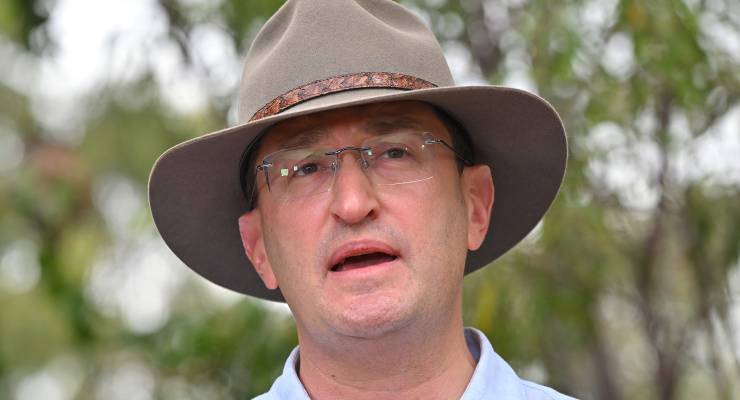
The “smart people of Canberra” can’t close the disadvantage gap that divides Indigenous and non-Indigenous Australians without a Voice to Parliament, proponents of the body claim.
Liberal MP and Yes campaigner Julian Leeser said governments would continue to do a “really bad job” at fixing the disadvantage experienced by First Nations peoples without better consultation.
“One of the key reasons that disadvantage hasn’t been addressed properly, is because smart people in Canberra will come up with ideas that don’t actually match what’s happening on the ground. And the purpose of the Voice is actually creating better public policy on the ground,” Leeser said.
The idea that a Voice to Parliament would help Australia in achieving the objectives of a national agreement on Closing The Gap is a key argument for the Yes camp. In the final weeks of the referendum campaign, proponents like Prime Minister Anthony Albanese have repeatedly brought up the Closing the Gap targets that Australian federal, state and territory governments signed up to in 2020.
Last week, Albanese told Guardian Australia the referendum campaign, even if it should fail at the ballot box, had already succeeded in focusing the national attention on Indigenous disadvantage.
“I think the awareness and consciousness of Indigenous affairs has been raised to the point whereby you’ll never again have — I don’t believe — a situation where you won’t have Indigenous affairs raised on the floor of the parliament. For a long period of time, it wasn’t front and centre of issues,” Albanese said.
The Productivity Commission said in July governments are failing to meet the targets under the agreement. Early development targets and high rates of Indigenous adult imprisonment, suicide, and children in out-of-home care all took a backward step, according to the commission. Targets on health, education, employment, housing, safety, and strength in culture and language were either improving too slowly or lacked sufficient data.
The only four socio-economic measures deemed on target by the commission were land rights, employment, pre-school enrollment and rates of young Indigenous people in detention.
The commission found some state and territory governments were making choices that “disregard or contradict” their commitments to the national agreement on Closing the Gap.
Queensland’s changes to its bail laws, Western Australia’s passing of its Aboriginal Cultural Heritage Act, and the Northern Territory’s changes to alcohol restrictions “without adequate consultation with Aboriginal communities” were cited as three examples, ABC News reported.
Some No advocates, like Nyunggai Warren Mundine, have downplayed the disadvantage faced by Indigenous peoples, arguing a Voice would not be necessary.
“The fact is, most Indigenous Australians are doing fine. They go to school, go to work, run businesses and take care of their families. And they aren’t in prison,” Mundine told the National Press Club last month.
“It’s wrong to tell young people growing up in these families that they are disadvantaged because they are Indigenous.”
Internally, the Yes campaign has acknowledged that a large slice of the voting public either are not aware of this disadvantage, or reject the assertion, and this is backed by focus group research.
But Leeser called the limited progress on the national agreement “shocking”.
“For more than 50 years, we’ve been making these policies that give Indigenous people, on average, a life expectancy that is shorter than the rest of the population. One in two Indigenous Australians are below the poverty line, and an Indigenous boy is more likely to go to jail than university,” he said.
“This is a shocking thing in a country like Australia that performs so well in every imaginable economic and social indicator.”
Leeser argued that better representations from Aboriginal and Torres Strait Islander people to the government would help close the gap.
As an example, he brought up a project by BreastScreen Victoria and the Victorian Aboriginal Community Controlled Health Organisation that consulted First Nations community organisations before developing a culturally sensitive program that helped increase rates of screening.
“The incidence of breast cancer among Aboriginal women is the same as it is among the general population, but the number of [First Nations] deaths from breast cancer is far higher,” Leeser said.
“What [the Victorian services] found was that there were reasons that Aboriginal women weren’t being scanned: one was an issue around modesty, and the other was an aversion to hospitals.
“So instead of asking women to go to the hospital for breast cancer screenings, they took the screenings to the community, and they developed shawls that women could wear during screenings. And as a result, the women came out in droves.”
Catherine Liddle, the CEO of peak First Nations children’s organisation SNAICC — National Voice for our Children, said the Closing the Gap agreement and the Voice were “two sides of the same coin”.
“We know that the Productivity Commission and numerous other reports are jarring because they are a reminder of how inept government policies and initiatives have been at improving educational development outcomes for Aboriginal and Torres Strait Islander children.”
“The gap in early education is getting worse, not better. At this point in time, 65.7% of First Nations children started school developmentally vulnerable in 2021. That’s a massive gap,” she told Crikey.
“What we know is that those things have to change. And we need to be able to have a say in the policies’ impact on us, we have to have a say in how government is managing our affairs.”
“The only way to overcome Aboriginal disadvantage is to ensure that Aboriginal and Torres Strait Islander people have a level of say in the issues that affect them.”
The national agreement on Closing the Gap, signed in July 2020 by state, territorial and federal governments, focused on four key reforms:
- Implementing partnership arrangements for joint decision-making between First Nations peoples and governments
- Increasing the amount of government funding going through First Nation community-controlled organisations
- Decreasing the proportion of Aboriginal and Torres Strait Islander People who experience racism
- Increasing the number of regional data projects to support Aboriginal and Torres Strait Islander communities to make decisions
Government ministers, the No campaign and Mundine did not respond to requests for comment from Crikey.








We would all have much better well-being if we could hear Aboriginal voices and learn different perspectives, by them being promoting nationally instead of confined to fringe media outlets. Take the example of breast screening cited here, these measures to accommodate aboriginal women’s objections would also help most women overcome their discomfort of breast screening programs, as the issues raised are problematic for many women as the process is embarassing, invasive, intrusive and makes many women feel vulnerable.
No doubt many migrant women are also uncomfortable with the process, as are women with body concerns (not a small percentage). Hospitals are also problematic places for many people, due to past traumas.
If we listen to aboriginal concerns, we might learn that we share many of them and that we can improve how things are done for all us.
The only hope I have if the referendum fails is that the Liberal Party will die off, the Coalition scattered and that they no longer have the power to close down any advisory body set up with representatives elected by Aboriginal people by a Labor Government
A Voice to parliament has been used in the past to great effect. Examining policy through a gender lens effectively and demonstrably closed the gender gap across a number of social indicators, particularly financial benefits and breaking down barriers. The sky did not fall in. When Abbott declared himself Minister for Women and abolished examination of legislation for any unintended consequences for women’ equal status, the statistics on closing the gender gap widened again. The Voice will help to close the gap in much the same way. It has to be in the Constitution to avoid conservatives and far right extremists from demolishing social gains every time they get put in charge.
Being in the Constitution will not necessarily add permanency.
We have unfinished business transitioning from a constitutional monarchy to a constitutional republic.
There may be changes to the Constitution in the next decade – and if the Voice model proposed doesn’t work, it may not persist – even if it wins this referendum and is put into the Constitution.
We are a Federation.
South Australia legislated a First Nations Voice, with the first vote to be held on the 16th of March 2024.
The other states could follow suit.
Suppose there is a national peak body for the Voice at the federal tier and the Commonwealth.
In that case, even if it may be legislated, and even if conservatives may dissolve it from time to time – as long as there are Voice bodies active in at least some of the states, you will have a template that can be used to model any Voice that is abolished and needs to be restarted.
It also provides the opportunity to test what works best, what is effective, and what is not.
Resilience. No matter what the outcome of the referendum.
I don’t see why it must be in the Commonwealth Constitution.
If we want to recognise the First Nations people in the Constitution, as I firmly believe we should, we should do it properly.
The current proposal is tacked on the end of the document and merged with some political body, which will gain a reputation through the people elected to it. Albanese tried a similar thing with local government around 10 years ago.
Recognition proper should be in a preamble at the beginning of the document.
Recognition of First Nations should be in a place of honour with the (to be democratic) Crown of Australia.
A common refrain is the claim that Aboriginal and Torres Strait Islander peoples have asked for this Voice to be in the Constitution.
I do not deny that, and I am not belittling that. I think recognition of the First Nations needs to be in the preamble to the Constitution.
That request was always contingent on a proposal and wording prepared and vetted by conservative Constitutional Experts.
Professors Twomey and Craven worked on numerous versions of the draft over many years.
Thats fine. It is a generous offer. A lot of careful work has gone into it, possibly most of it pro bono.
But I find the claim that Aboriginal and Torres Strait Islander people demand that the Voice be put in the Constitution as opportunistic. This option is only contingent on the top constitutional experts devoting considerable time and effort to make this option available. Embedding the changes in the Constitution would not be the first thing to discuss at the pub – for any demographic.
Watch out for the Moops….. I was wondering what happened to ‘The Bubble Boy’.
… Changed his name from Donald to Warren?
This says it all.